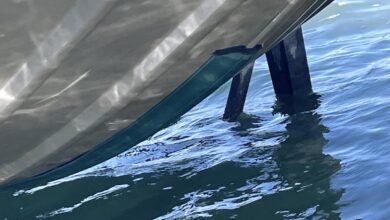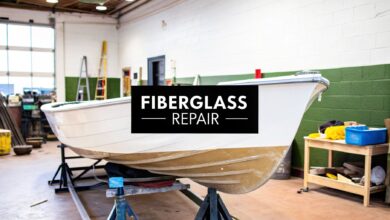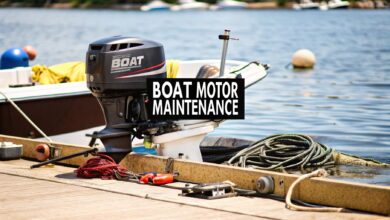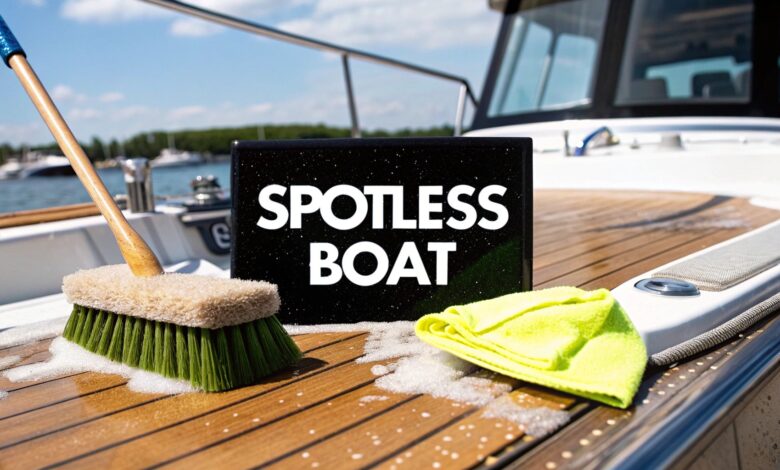
Before you get the boat wet, the real work begins with gathering your gear. A well-stocked cleaning kit is the secret weapon of any seasoned boater. This isn't just about soap and a bucket; it's your pre-launch checklist for a top-notch clean.
The Ultimate Checklist for a Gleaming Boat
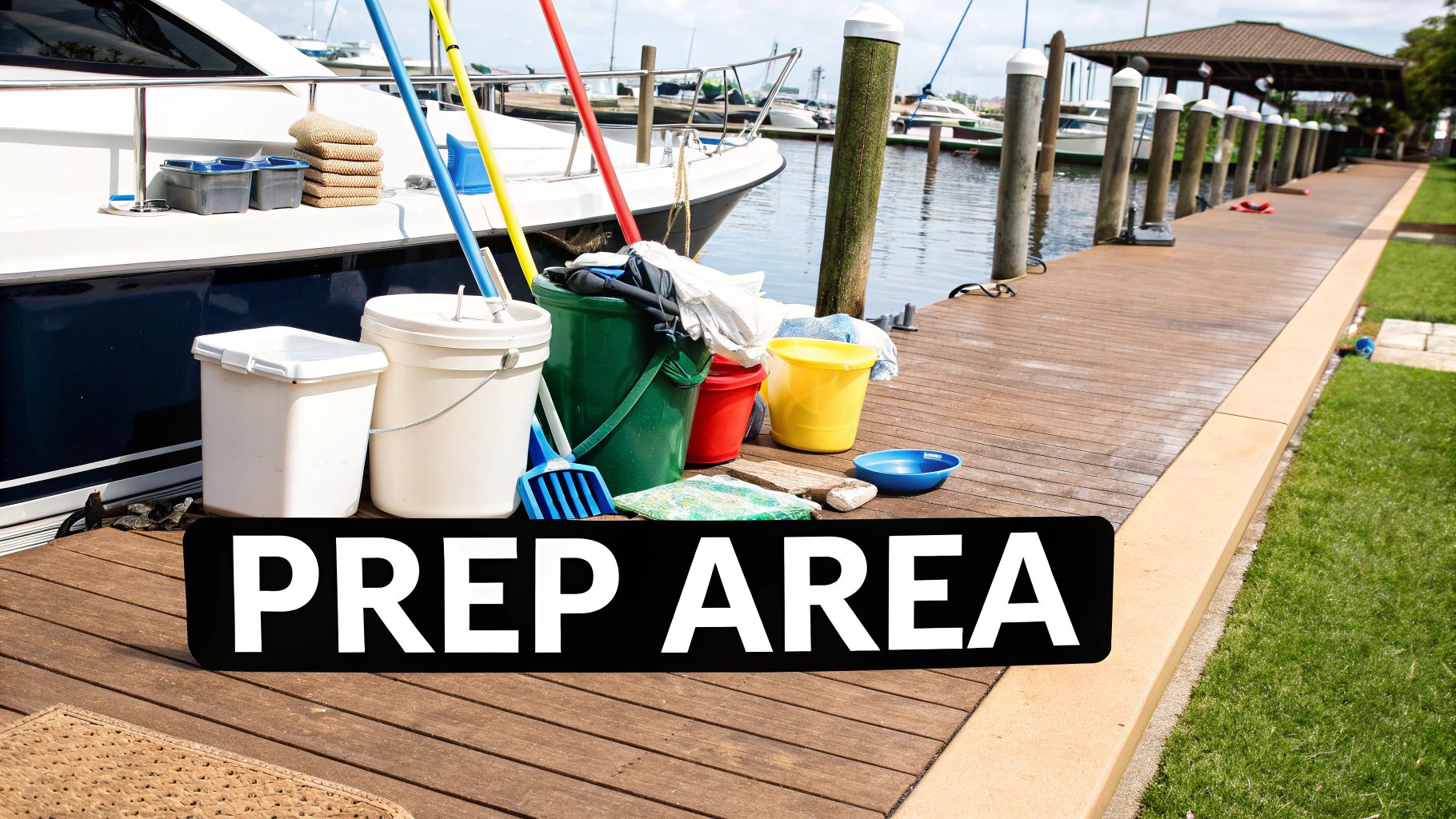
Getting that showroom shine starts long before a single drop of water hits the deck. The magic is all in the preparation and picking the right tools for the job. Using the wrong stuff can do more harm than good, like scratching the gelcoat or stripping wax.
Your boat has a mix of surfaces like gelcoat, non-skid decks, vinyl seats, and canvas covers. Each one needs its own specific kind of care. A "one-size-fits-all" mentality is a shortcut to faded finishes and expensive repairs.
To make sure you're fully prepared, I've put together a quick-reference table. It breaks down exactly what you'll need, area by area.
Essential Boat Cleaning Supplies Checklist
| Category | Essential Items | Pro Tip |
|---|---|---|
| Washing & Scrubbing | Soft-bristle brush (for hull), Medium/Stiff-bristle brush (for non-skid), Extendable pole, Two 5-gallon buckets | Color-code your brushes (e.g., blue for hull, white for deck) to prevent transferring abrasive grit onto smooth surfaces. |
| Drying & Polishing | Bulk pack of microfiber towels, Foam applicator pads | Use microfiber for a lint-free, swirl-free dry. Foam pads are best for applying wax evenly without wasting product. |
| Cleaners & Solutions | Marine-grade boat soap, Vinyl cleaner/protectant, Mildew stain remover, Glass cleaner | Always choose marine-specific, biodegradable soaps. They're designed to be effective without harming aquatic life. |
| Personal Safety | Waterproof gloves, Safety glasses/goggles | Don't skip these. Boat cleaning chemicals can be harsh on your skin and eyes, especially heavy-duty degreasers. |
With these items ready, you’re set up for a smoother and more effective cleaning day.
Brushes: Your First Line of Attack
The foundation of a good boat cleaning kit is a solid set of brushes. You really need at least two different types. First, a soft-bristle brush with flagged tips is what you'll use on the hull and any other smooth, gelcoated areas to avoid scratches.
For those textured non-skid decks, you'll need to switch to a stiffer bristle brush. This is the only way to get deep into those grooves and lift out stubborn dirt. An extendable handle is a back-saver and a game-changer for reaching the entire hull.
Pro Tip: Rinsing your brush in a separate bucket of clean water before dipping it back into your soapy water is a classic detailer's trick. It keeps grit and grime from going right back onto the boat.
Cloths and Applicators for That Finishing Touch
When it comes to drying and polishing, microfiber is king. These cloths soak up a ton of water and are gentle enough that they won't leave behind lint or swirl marks. I always keep a big stack of them on hand.
You'll also want some foam applicator pads for putting on wax or polish. They help you apply a thin, even coat, which is more effective and easier to buff out. For a comprehensive look at the entire cleaning process, this guide on how to clean your boat is a fantastic resource.
Don't Forget Your Own Safety
Finally, a quick word on protecting yourself. Cleaning chemicals can be nasty. Always have a pair of durable, waterproof gloves and some safety glasses ready to go, especially when using stronger stuff.
Tackling the Hull and Deck: A Pro-Level Approach
Your boat's hull and deck take a constant beating from the elements. They're the first line of defense against saltwater, sun, and scuffs. Keeping them in top shape is about more than just looks; it’s fundamental to your boat’s longevity.
Before you use soap, give the entire boat a good freshwater rinse from the top down. This knocks off all the loose salt, bird droppings, dust, and grime. Skipping this step can create a gritty paste that acts like sandpaper on your gelcoat.
Once rinsed, it’s time to break out a quality marine-grade boat soap. Always work in small sections using the "top-down" method. This prevents the soap from drying out and baking onto the surface, which causes frustrating streaks.
The Right Way to Work on Hull and Deck Surfaces
Always start with the highest point of your boat—the flybridge or cabin roof—and clean down to the waterline. This systematic approach ensures you’re not washing dirty water over areas you’ve just cleaned. It makes all the difference.
This handy visual breaks down the thought process for choosing the right tools and products for the job.
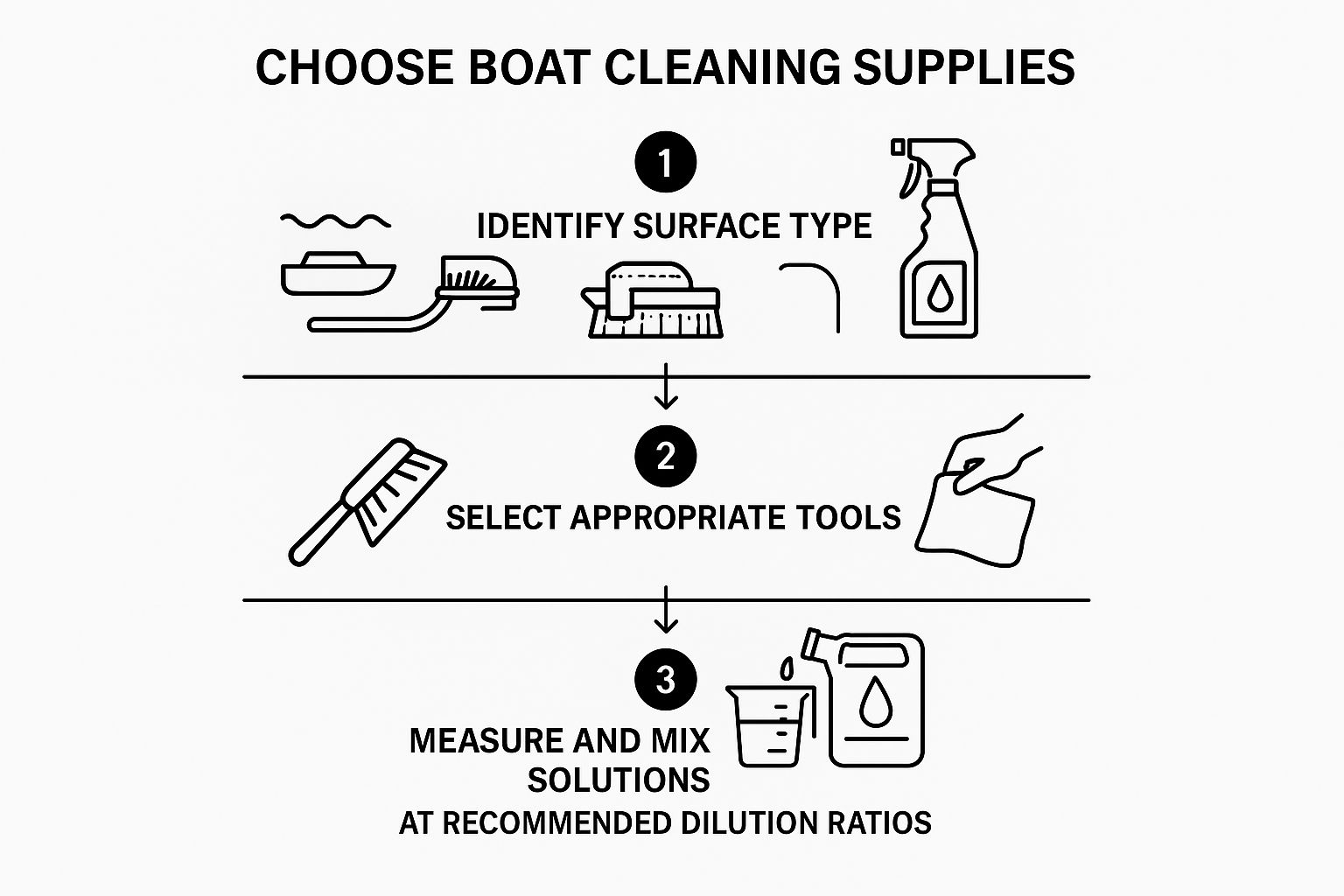
Following a logical sequence like this means you’re matching the right cleaner to the right surface. This is key to avoiding damage and getting the best possible results.
Dealing with Stubborn Stains and Problem Spots
Every boater struggles with ugly "smiles" at the waterline caused by algae and mineral buildup. Don't scrub them aggressively; you'll just wear yourself out and risk damaging the gelcoat. The smart move is to use a dedicated hull cleaner that chemically dissolves the stains.
For non-skid deck surfaces, a medium-stiff deck brush is your go-to tool. Apply your boat soap, let it work into the crevices, then scrub in a circular pattern. This helps lift the grime out from every angle.
Cleaning isn't just a chore; it's a critical part of boat maintenance. The global market for boat hull cleaning is already worth around $500 million. It's expected to grow as environmental regulations get stricter. For more on this, check out this guide on how to clean boat hull.
For really baked-on grime, it's helpful to see how pros handle similar surfaces. You can find useful tips in these expert deck cleaning methods that often apply to non-skid decks.
The Final Rinse and Dry
After all that work, the final rinse is where you can make or break the finish. Start from the top again and wash away every last trace of soap and dirt. Any residue left behind will attract new grime.
When it's time to dry, put away old bath towels that leave lint everywhere. Use a high-quality synthetic chamois or a stack of clean microfiber towels instead. A proper dry-down prevents water spots and leaves the surface perfectly prepped for wax.
Deep Cleaning Your Interior Cabin and Galley
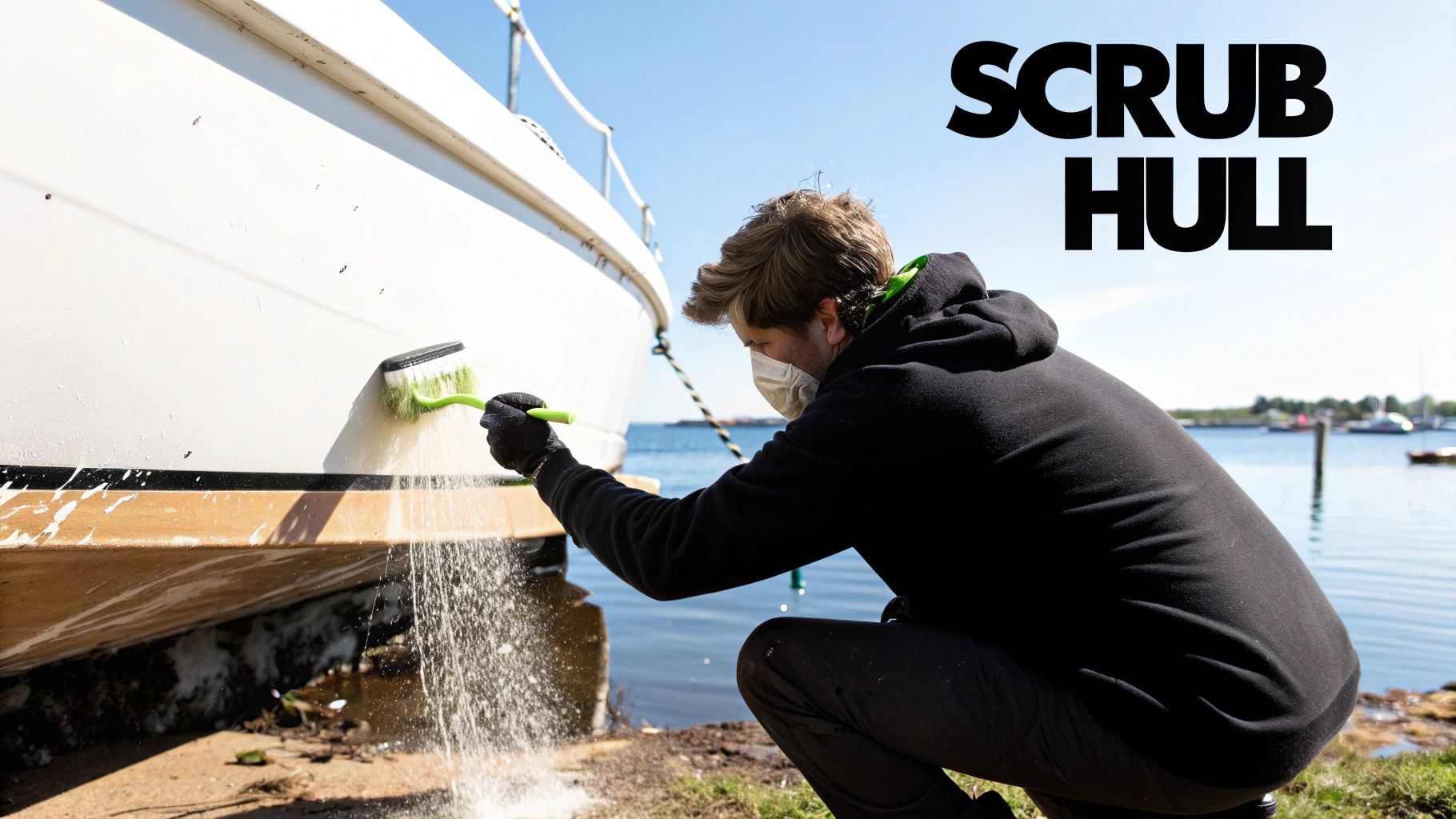
With the exterior shining, it’s time to move inside. Keeping the cabin and galley clean is about protecting your investment and your health. Boat interiors are damp, confined spaces, which is an open invitation for mold and mildew.
Break the job down into smaller tasks. Start by getting everything out of the lockers and storage compartments. This gives you a clean slate and often uncovers hidden grime or early signs of mildew.
Handling Interior Surfaces and Materials
Your boat’s cabin is a mix of wood trim, vinyl headliners, and galley counters. Each one needs a slightly different touch. A generic all-purpose cleaner can harm delicate finishes.
For wood trim, stick with a pH-neutral wood cleaner and a soft microfiber cloth. Follow up with a good marine wood polish to protect it from moisture and UV rays.
Vinyl headliners and wall coverings are magnets for dust and mildew.
- For a general wipe-down, mild soap and water on a damp cloth is all you need.
- To kill mildew spots, a 50/50 mix of white vinegar and water works wonders.
- For stubborn stains, use a dedicated marine vinyl cleaner, but test it on a hidden spot first.
I’ve seen people use bleach on their interior vinyl. It kills mildew but also weakens the vinyl over time, making it brittle and prone to cracking.
Sanitizing the Galley and Head
The galley needs to be sanitary, not just tidy. Use a food-safe disinfectant on countertops and the sink. Give the sink drain some attention, as it’s a common source of bad smells.
Pull everything out of the microwave and refrigerator for a proper cleaning. I wash fridge shelves and drawers with warm, soapy water. An open box of baking soda in the clean fridge helps absorb lingering food smells.
The head requires its own special care to keep odors and bacteria from taking over. You must use a toilet cleaner made specifically for marine systems. Household cleaners can destroy the seals and valves in your boat's plumbing.
If you’re dealing with smells that just won’t quit, there are some very effective odor removal methods that can save the day.
Winning the Battle Against Mold and Mildew
Living on the water means a constant fight against moisture. Mold and mildew aren’t just ugly; they can cause health issues and that musty boat smell. Your best weapon in this fight is proper ventilation.
Open up hatches and portholes to get air moving whenever you can. I also swear by moisture-absorbing products in lockers and other closed-off spaces. A small dehumidifier is a game-changer if you have persistent humidity.
Think of good organization as part of your cleaning routine. Before you stow any gear, make sure it’s completely dry. Shoving wet life jackets or towels into a locker is like planting a mildew farm.
Caring for Upholstery, Canvas, and Vinyl
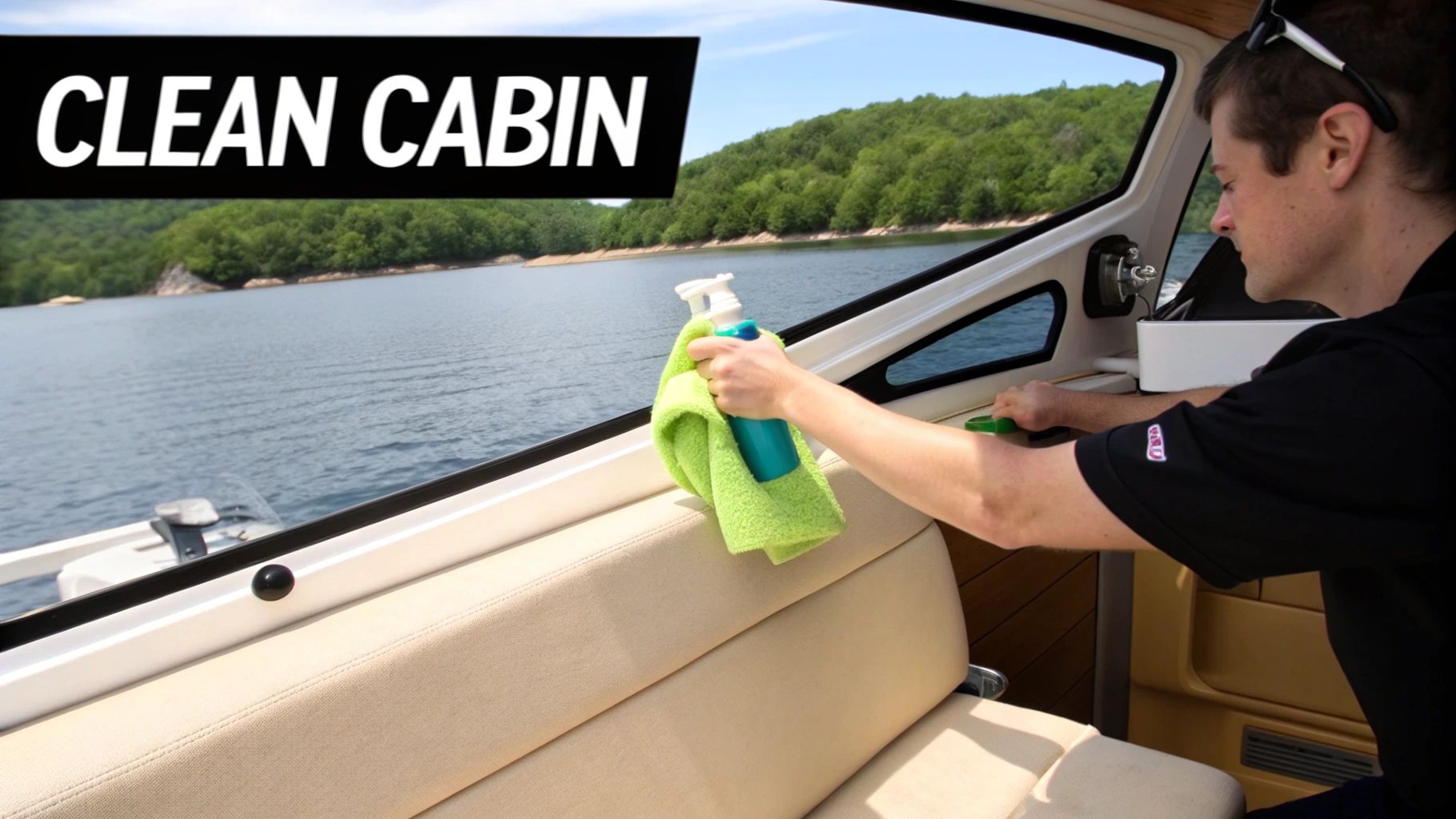
Your boat’s vinyl seats, bimini top, and canvas covers are on the front lines against sun and salt. These materials need specific care. A generic cleaner can strip away their protective coatings.
Taking care of these surfaces is a core part of boat maintenance that protects your investment. If you let it slide, you're looking at expensive replacements. The right approach will keep everything looking sharp for many seasons.
Tackling Stains on Vinyl Upholstery
Vinyl seats attract stubborn messes like sunscreen, bird droppings, and mildew spots. Don't use harsh chemicals, as they can dry out the vinyl and cause cracking. Always start with the gentlest method first.
For routine wipe-downs, a mix of mild marine soap and water with a soft brush works perfectly. When you're dealing with specific problems, you'll need a more targeted, but still safe, strategy.
- Sunscreen Stains: You'll likely need a dedicated marine vinyl cleaner to break down these oils.
- Bird Droppings: Get these off fast. Soak the spot with fresh water, then gently wipe it away.
- Mildew Growth: For light mildew, a mix of one part white vinegar to three parts water is a great first step. For stubborn stains, you’ll need a specialized marine mildew remover.
A tip I can't stress enough: rinse, rinse, rinse. After cleaning, douse the vinyl with fresh water to get all the cleaner off. Any residue left behind can attract more dirt.
Learning to maintain your upholstery is a crucial skill. For a deeper look, check out our guide on how to clean boat seats.
Reviving and Protecting Canvas
Your boat's canvas is its main shield against the elements. Over time, its factory-applied water repellency wears thin. Cleaning and re-treating your canvas should be on your annual to-do list.
First, gently sweep off any loose dirt and debris with a soft brush. Next, use a cleaner made for marine canvas and give it a light scrub. For greener options, explore non-toxic upholstery cleaning methods that are effective and eco-friendly.
After cleaning and rinsing, let the canvas dry thoroughly. This is a non-negotiable step. Applying a waterproofing spray to damp fabric results in a splotchy, useless coat.
Maintaining Clear Vinyl Windows
The clear vinyl windows on your enclosure, often called Isinglass, need a delicate touch. These surfaces scratch incredibly easily. Never use a standard glass cleaner, as the ammonia will ruin the vinyl.
Start by rinsing the windows with plenty of fresh water to wash away salt or dirt. Then, use a product formulated for clear vinyl with a fresh microfiber cloth. This gives you a crystal-clear finish without creating micro-scratches.
Adopting Eco-Friendly Boat Cleaning Habits
As a boat owner, you are a steward of the waters you explore. Shifting to eco-friendly cleaning protects marine life. It is also often gentler on your boat's sensitive finishes.
This means moving away from harsh chemicals and embracing sustainable habits. Every choice, from your soap to where you wash your boat, makes a difference.
Choosing Genuinely Marine-Safe Products
The most important step is to get picky about your cleaning supplies. Look for products labeled biodegradable and phosphate-free. Phosphates act like fertilizer for algae, causing blooms that harm fish and other aquatic life.
Don't be fooled by a "green" label; read the ingredients. Truly marine-safe cleaners break down into harmless elements once they hit the water. They don't stick around as pollutants.
I’ve spent countless hours watching the vibrant ecosystems under marina docks. When you wash your boat, any runoff flows directly onto that life. Choosing a non-toxic cleaner means you're not poisoning that environment.
Understanding and Complying with Regulations
Responsible boating means knowing and following the rules. Laws like the Clean Water Act prevent pollution from all sources, including recreational boats. Using non-compliant chemicals can lead to hefty fines.
Many marinas have strict policies on what cleaners you can use. They often require you to use designated wash-down stations that treat runoff. Always check with your marina or local authorities for specific rules.
For a good starting point, consider these effective options:
- Biodegradable Soaps: Products like Star brite's Sea Safe clean well without leaving a toxic mess.
- DIY Solutions: For light jobs, a simple mix of white vinegar and water works wonders.
- Baking Soda Paste: A paste of baking soda and water can lift grime without scratching most surfaces.
Practical Ways to Contain Runoff
Controlling where your dirty water goes is one of the most effective things you can do. Whenever you can, wash your boat on land and well away from the water's edge. This lets you manage the greywater and stops runoff from reaching the water.
If you must clean your boat in its slip, use products made for that situation. Be mindful of your water usage and look into "waterless" or "spray and wipe" cleaners. These products dramatically reduce what ends up in the water.
The Environmental Impact of Biofouling
That buildup of algae and barnacles on your hull is known as biofouling. It's more than an eyesore that slows you down. Those organisms can be invasive species that you transport to other bodies of water.
Regular hull cleaning is your best defense. A clean hull prevents the spread of invasive species and makes good financial sense. A fouled hull can increase your fuel consumption by 10-15%. That alone is a powerful incentive for staying on top of maintenance. You can read more about the findings on the environmental boat cleaning market to see how the industry is evolving.
Answering Your Top Boat Cleaning Questions
No matter how many times you've cleaned your boat, tricky questions pop up. Let's tackle some of the most common ones I hear from fellow boaters. We'll cover everything from cleaning frequency to getting rid of stubborn mildew.
The goal here is to give you the confidence to handle whatever grime your boat throws at you.
How Often Should I Really Be Cleaning My Boat?
The right cleaning schedule depends on how and where you boat. There’s no magic number, but there are some solid rules of thumb. Your environment is the single biggest factor.
If you're a saltwater boater, a thorough freshwater rinse after every single trip is non-negotiable. Salt is incredibly corrosive and will damage your boat if left to sit. Beyond that, a full wash-down with marine soap every two to four weeks is essential.
For those on freshwater, things are more relaxed. A good, soapy wash once a month is usually plenty. Everyone should plan for a deep, top-to-bottom clean at least twice a year.
Is It Okay to Use Household Dish Soap on My Boat?
The answer is a hard no. Using household dish soap on your boat is one of the worst things you can do for its finish. These powerful degreasers create much bigger problems.
That aggressive action strips the protective wax right off your boat's hull. Once that wax is gone, the gelcoat is defenseless against the sun's harsh UV rays. This exposure is what causes oxidation, leaving your finish looking chalky and faded.
A professional marine detailer I know put it perfectly: "These cleaners will strip away wax or sealants from your boat's surface, leaving UV rays a wide-open door to oxidize the gel coat, starting that instant."
Stick with a dedicated marine boat soap. These are pH-balanced to clean without removing that critical protective layer. Saving a few bucks on soap isn't worth the cost of restoring an oxidized hull.
How Do I Get Rid of Stubborn Mildew on Vinyl Seats?
Mildew on vinyl upholstery is a common battle, but it’s one you can win. You need a cleaner that kills the mildew spores without damaging the vinyl. Your first move should be a dedicated marine mildew stain remover.
For lighter stains, a mix of one part white vinegar to three parts water can work wonders. Let it sit, give it a gentle scrub with a soft-bristle brush, and rinse it clean. For deep, set-in stains, a commercial-grade marine product is your best bet.
- Test a Spot First: Always test your cleaner on a hidden area to ensure it doesn’t discolor the vinyl.
- Prevent It from Coming Back: Once clean and dry, apply a quality marine vinyl protectant.
- Block the Sun: Look for a protectant with a UV inhibitor to shield the vinyl from sun damage.
What Are the Best Eco-Friendly Boat Cleaners?
We have a responsibility to protect the waters we love. Choosing eco-friendly cleaning products is a huge part of that. Look for products clearly labeled as "biodegradable," "phosphate-free," and "non-toxic."
Great brands like Star brite's Sea Safe line, Simple Green Marine, and Eco Works Marine offer effective, safe cleaners. And for simple, day-to-day cleaning, you don't always need a heavy-duty product.
A spray bottle of white vinegar and water is a fantastic glass cleaner. A paste of baking soda and water works surprisingly well for extra scrubbing power. Just be sure whatever you use is safe for marine ecosystems.
For more expert guides, product reviews, and practical advice to improve every aspect of your time on the water, visit us at Boating Articles. Find everything you need to know at https://boating-articles.com.

